Listed below are a number of variations and optional rules that are sometimes used when playing Rummy. There are also a number of other games that have been derived from Rummy (such as Canasta, Gin Rummy,
etc.). However, as differences found in those games are significant, each of those games has been provided with its own separate write-up, which can be found at the Cats at Cards home page.
Call Rummy: This is an optional rule that is sometimes played amongst more experienced players of the game. It is not usually recommended when there are beginning players at the table such as not to punish unduly those new to this game.
Using this rule, if any player discards a card that could be laid off to an existing meld already on the table, any other player may say "Rummy!" The first player to call Rummy can then take the card and immediately add that card to the appropriate meld on the table. If two or more players simultaneously call Rummy on the same discard, the player who is closest in a clockwise direction to the original discarder's left is allowed to make the play. After making the meld, this player must then discard any card form his hand. Play would then continue with the next player after the original player whose turn it was. A player declaring "Rummy" must do so before the next player begins his turn by drawing a card. A player who just finished their turn may not call Rummy on their own discard. Rummy may never be called on a discard on a players last turn.
Game Win Criteria: Some players raise the game win score requirement from to 200 or some other increased score for a longer game. In some games, scoring is not recorded at all and each hand is considered its own game with the first player to run out of cards winning not only the hand but also the game. When this rule is used, the winner usually deals the next hand.
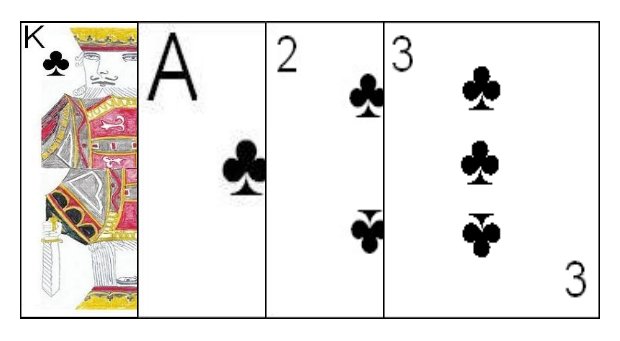 Around the Corner Rummy
Around the Corner Rummy: In this variation, the Ace, at the players option, can be ranked above the King or below the two. In addition, a sequence meld can extend "around the corner". In other words, a sequence meld that reaches the highest value (Ace) can start back at two. For instance King Diamonds, Ace Diamonds, Two Diamonds and Three Diamonds would be a legal meld. When this optional rule is used, the Ace is counted as 11 points when found remaining in a players hand.
Borrowing a Card: This variant rule allows a player to take a card from one of his own existing melds on the table during his turn. If doing so, however, the player must immediately use the card in a new meld. This may only be done if the meld was originally placed by the same player.
Additional Borrowing: This is similar to the normal optional rule for borrowing, however in this version, a player may borrow a card from any other meld on the table, regardless of the player who initially first placed the meld.
One Meld per Turn: Another variation that is commonly used is that a player may only meld one group per turn. If a player does not meld on the turn he may elect instead to lay off cards on his own or another players melds, if able.
Restriction on Laying Off Cards: Another variation which is often seen in Rummy games is a restriction on laying off cards on another players meld. Using this variation, a player may not lay off cards on other players melds until they have made their first meld to the table.
Rummy Concealed: Using this variation, if a player does not play any melds to the table (including laying off cards on other players melds) until he can play all his cards at once, he is said to have Gone Rummy. When doing this, the player scores double the value of all cards left remaining in his opponents hands.
Mandatory Discard Rule: Another variation involves changes in the requirements for going out. In this version, a player must go out with a discard. A player may never go out by melding his last card, but must end the turn (and the hand) by discarding his last card to the discard pile.
Rummy Complete: Using this variant, no melds are laid down during the course of the hand. Instead, a player retains any melds in his hand and may only play his melds when he is able to meld his entire hand (or his entire hand minus one discard) to the table. At this point, he would then lay his entire hand down in the appropriate melds and collect from each other player the full value of all cards held in there hands. As this game can result in higher scores per hand, the game total is usually raised to 200 or more points to win the game.
Card Values: In some games, instead of counting each card by its displayed pip value, the player scores 1 point for every card remaining in his opponents hands. When this scoring system is used, the game is usually played to a lower game win total, such as 25. When this scoring option is used with Rummy variations that include Jokers, the Jokers are usually scored at two points each.
Block Rummy: Block Rummy differs from Standard Rummy in rules regarding when the discard pile runs out. In this variation, once the discard pile runs out play continues as long as each player in turn takes the top card of the discard pile. Once any player declines the discard pile the hand instantly ends. At this point, all hands are instantly exposed on the table. Each player should then add the total of all cards remaining in their hands. The player with the lowest count earns the difference between their count and that of each opponent. If two or more players tie for the lowest count, the scores are divided as evenly as possible amongst the winners. Any indivisible points are not awarded to any player.
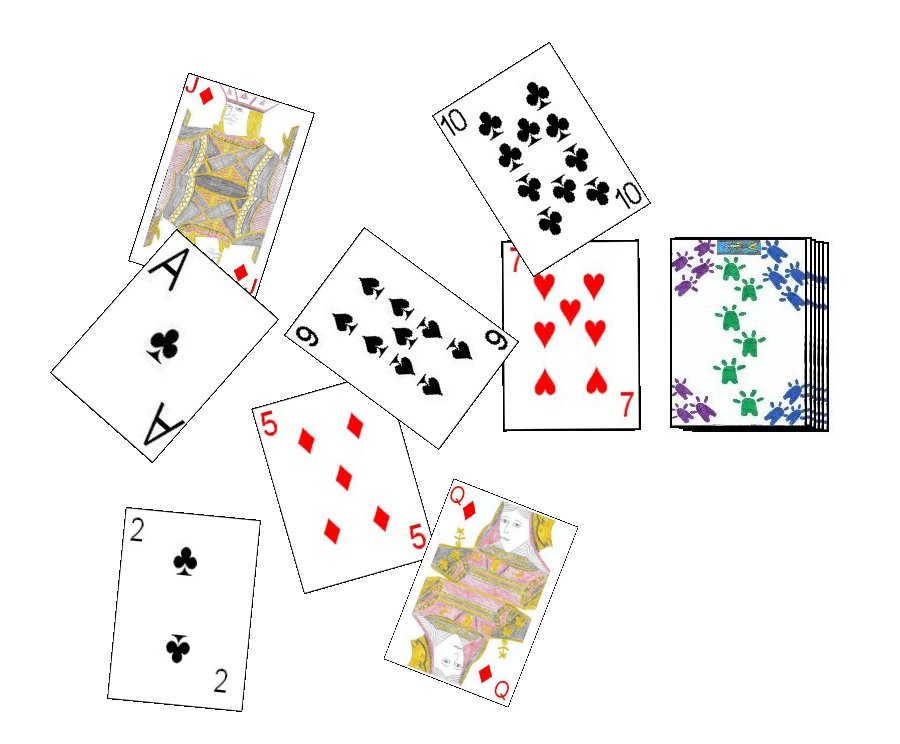 Throw Down Rummy
Throw Down Rummy: This is a variation created by the cats which is great fun at parties. The rules are similar to Standard Rummy with variations based on drawing from the discard pile. At the end of his turn, when discarding, instead of placing the discard neatly on the top of the current discard pile, the player simply tosses his card toward the discard pile. In this way, the discard "pile" ends up being a haphazard array of face up cards. If the tossed card flies off the table, ends up flipping to be face down or otherwise ends up in an inappropriate place, it should be righted and placed somewhere in the discard area. As there is no obvious order or top card of the discard pile, when drawing a discard, a player can take any discarded card in the discard area. As in other versions of Rummy, the player can also take the top of the stock pile. A player may only take one card on his turn, and he may take a card that is somewhat buried under other cards. Cards may only be moved, however, to get another discard that may be partially covered by that card. In other respects this version is played identically to Standard Rummy.
Boat House Rum: Boat House Rummy is also played similar to standard Rummy with a few key differences, primarily in rules regarding drawing from the discard pile. As in the standard game, a player, at the beginning of his turn can draw either the top card of the stock or the top card from the discard pile. However, if he draws the top card from the discard pile, he then must also draw the next card in the discard pile or the top of the stock pile. As in normal Rummy, he discards only one card to the top of the discard pile.
In Boat House Rummy, Aces can be considered either high (above King) or low (below deuce) and may also be used in Around the Corner sequence melds as in "Around the Corner Rummy". For scoring purposes, when found in an opponents hand, they score 11 points for the winner of the hand.
A player may not lay melds down during the hand until able to lay his entire hand down in legal melds (or he may meld all but one card which he discards). When this happens the hand ends. At this time, the other players then lay down their hands, separating out their own melds from non meldable cards. The winner of the hand scores for all unmelded cards in his opponents hands.
Caloochi: This variation, also called Kaluki, Kaloochi and Kalougi is played similar to standard Rummy and is designed for 2, 3 or 4 players. The deck used for Caloochi is two standard 52 card decks with four Jokers shuffled in. Each player is dealt 15 cards to begin the hand.
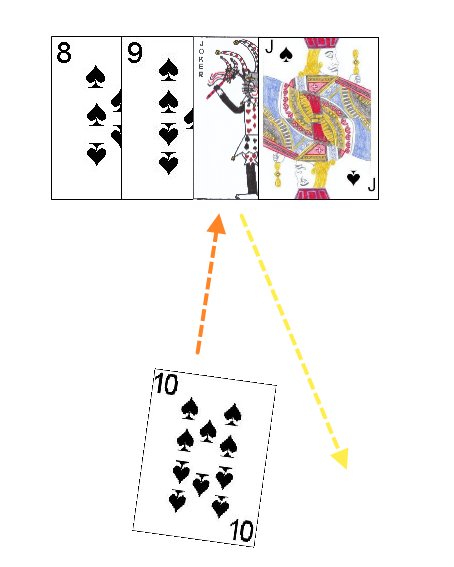
For sequence melds an Ace is ranked as either high or low. However, Around the corner melds are not allowed. Thus, a player could make melds of (Ace, 2, 3, 4 of Spades) or (Jack, Queen, King, Ace of Diamonds) but a sequence such as (King, Ace, Two) is not allowed. When scoring, the scoring is the same as in the standard game except for Aces which are 15 and Jokers which are 25.
A player's first meld on a hand must total 51 or more points. After making his initial meld in a hand, that player may then make additional melds (or lay off on other melds) to the table without the restriction. Until a player has made his initial meld, he may also not take cards from the discard pile, but only the top card of the stock. However, he may take the top card of the discard pile to use it immediately in his initial meld.
Jokers are wild cards and may be used to replace any other normal card. When used in this way, for calculating the value of a players initial meld, the Joker would have the score of the card it is replacing. On a players turn, after drawing but before melding or discarding, the player may replace a Joker in any other meld on the table with the natural card it represents, adding the Joker to his hand and replacing it with the actual card it was intended to represent. Because of this, when a Joker is used in a group meld consisting of exactly three cards, the individual melding it must indicate the card the Joker represents.
When a player plays his last card, he scores all points remaining in the other players hands.
There are a number of commercial, proprietary games based on Caloochi which often feature the use of colored and numbered tiles in place of playing cards.
Double Rum: This variation is similar to the standard version, however it uses a larger pack and has a few other differences. Two regular 52 card decks, plus four Jokers, all shuffled together are used for this game. An Ace is considered to be high or low in Double Rum. Thus, a sequence meld may contain Ace, 2, 3 or Queen, King, Ace. Around the corner melds, however, may not be made. Jokers are wild and may be used to replace any missing card in any meld at the melder's option. Group melds are allowed that contain identical cards of the same rank and suit.
If a Joker is found as either the first or last card in a sequence meld, a player adding to the meld is allowed to move the Joker to the other end in order to lay off additional cards to that meld. When scoring cards left in the opponents' hands, picture cards count 10, Aces 11, Jokers 15 and the other cards the pip value marked on the face of the card.
Knock Rummy:
Knock Rummy is the direct forerunner of the game Gin Rummy (which is described on its own separate page).
Like Standard Rummy, this game uses a standard 52 card deck. The ranking used in Knock Rummy is, from high to low: King, Queen, Jack, 10, 9, 8, 7, 6, 5, 4, 3, 2, Ace. Knock Rummy is played by 2 to 5 players who each play independently for himself.
The procedure of determining the first dealer, shuffling and cutting are the same as in Standard Rummy. The number of cards dealt is dependent on the number of players participating in the game as per the following chart:
| Players | Cards Dealt |
|---|
| 2 | 10 |
| 3 or 4 | 7 |
| 5 | 6 |
The cards are dealt out in the standard fashion, in a clockwise direction, one face down card per player.
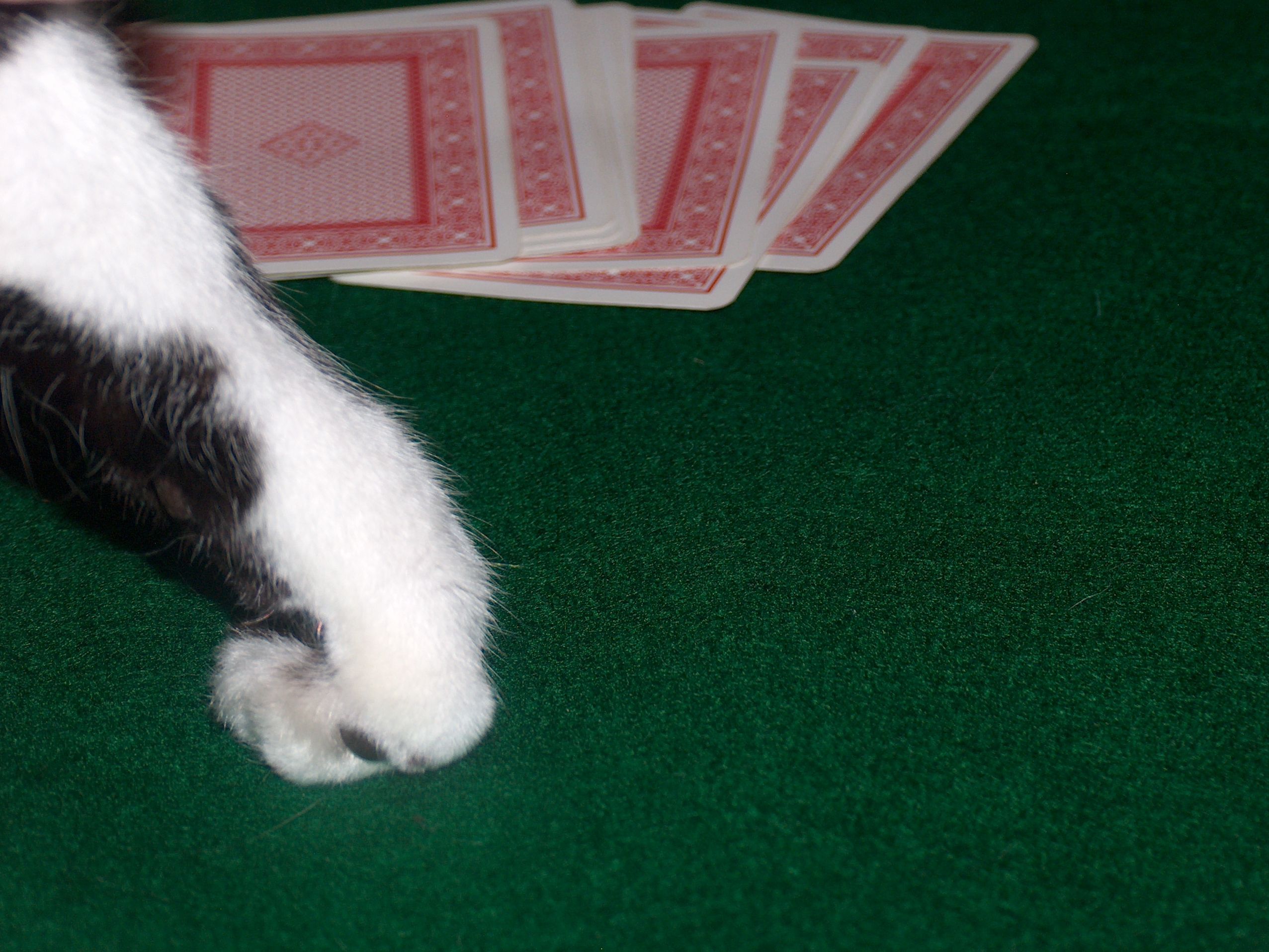
Similar to Standard Rummy, a turn begins with drawing a card and completes with a discard, with the player attempting to create the standard Rummy melds. However, unlike Standard Rummy, a player never lays down his intermediate melds on the table but rather keeps them in his hand.
On his turn, after drawing but before discarding a player may Knock which immediately ends the hand. The player can simply state "I Knock" or can physically rap his knuckles on the table to indicate this. He then discards one card, lays down his hand, separating out all his legal melds from his unmatched cards (called deadwood) and then announcing his total in unmatched cards. For this purpose the cards have the following values: Each face card is 10 points, Aces are 1 point each and all other cards have a count value equal to the pip value marked on them.
The other players then do the same, separating out their melds and their unmatched cards, announcing their count.
If the knocker has the lowest count in unmatched cards he is declared the winner of the hand, earning a point value equal to the difference between his own count in unmatched cards and that of each other player. If a player manages to go Rum (all his cards are in matching sets), he earns an additional 25 point bonus for each opponent participating in the hand.
However, if another player ties the knocker, that opponent wins the hand instead winning the difference in counts between his count and the other players.
If another player has a lower count than the knocker, that player is also considered the winner. He not only gets the difference between his and each other players counts, but also earns a 10 point bonus from the knocker (who must subtract 10 points from his own score).
If the knocker goes Rummy and another player also has Rummy, the knocker is still considered the winner and still retains the privilege of collecting the 25 point bonus from the player he tied as well as the other players.
The first player to have accumulated 100 points at the end of a hand is declared the winner of the game.
Continental Rum:
Continental Rummy is a great Rummy game for larger number of players. This game uses two or more packs depending on the number of participants in the game (from 2 to 12):
| Players | Decks Used |
|---|
| 2, 3, 4, or 5 | 2 |
| 6, 7, or 8 | 3 |
| 9, 10, 11, or 12 | 4 |
Each of these decks to be used in the game consists of the standard 52 card deck plus one Joker. The ranking of the cards for Continental Rum is as follows (in ascending order): Ace, 2, 3, 4, 5, 6, 7, 8, 9, 10, Jack, Queen, King, Ace. Aces can be used either at the top of a sequence including the King or at the bottom of a sequence including the two. Sequences can never go around the corner (the Ace would be the highest or lowest cards in those sequences).
The shuffle, cut and deal are similar to Standard Rummy, however each player receives 15 face down cards. The winner of each hand deals the next.
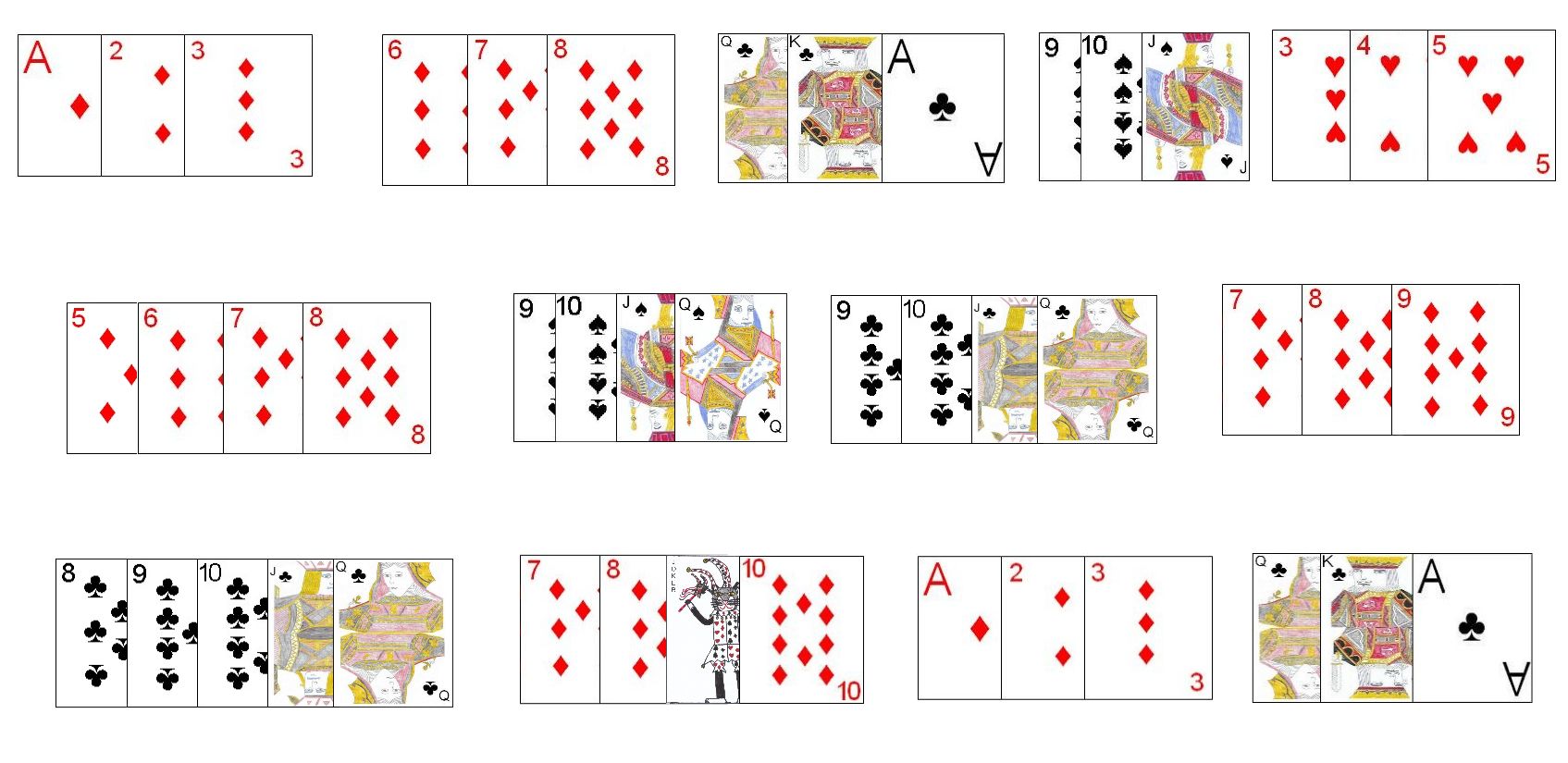
The play of the hand is also the same as in the standard game of Rummy (drawing and discarding), however a player may never make intermediary melds and must meld his entire hand at once when he can. In order to make his meld and win the game, the players melds must fit into one of the following patterns:
- One five card sequence, one four card sequence, and two three card sequences
- Three four card sequences and one three card sequence
- Five three card sequences
Sequences are the only legal meld types, with groups not permissible. As part of his melds a player may have multiple sequence melds in the same suit. Jokers are wild cards and may be used as a replacement of any other card in a meld.
When a player goes out by melding all 15 cards at once (and discarding one card), he collects one point from each opponent for winning the hand. In addition, he collects an additional two points from each other player for every Joker he used in his melds. Each other player would then subtract the appropriate number from their own score while the winner of the hand would add the scores earned to his own. Traditionally, each player begins the game with a set number of positive points such as 100. At the end of a set number of hands, the player with the highest current total is the winner of the game.
Continental Rum Variants: There are a number of variants often played with Continental Rum, including the following:
- In addition to Jokers, Deuces (twos) are also considered wild and may be used to replace any other card in a player's melds. When scoring the player would earn an additional point from each player for every Deuce used as a wild cards in his melds. If a Deuce were actually used in the position of a 2, it would not count as a wild card in this circumstance.
- Fast Melding Bonus Scores: If a player can meld his complete hand before drawing a single card he earns a 10 point bonus from each other player. If a player can meld his entire hand after drawing only one card, he earns a 7 point bonus from every other player.
- Special Meld Bonus Scores: Additional bonuses are sometimes added as well; For winning the game without using any wild cards (Jokers or Deuces used as wild cards) a player earns a bonus of 10 points from each other player. For having all 15 of his melded cards in the same suit, he also earns a bonus of 10 points from each other active player in the game.
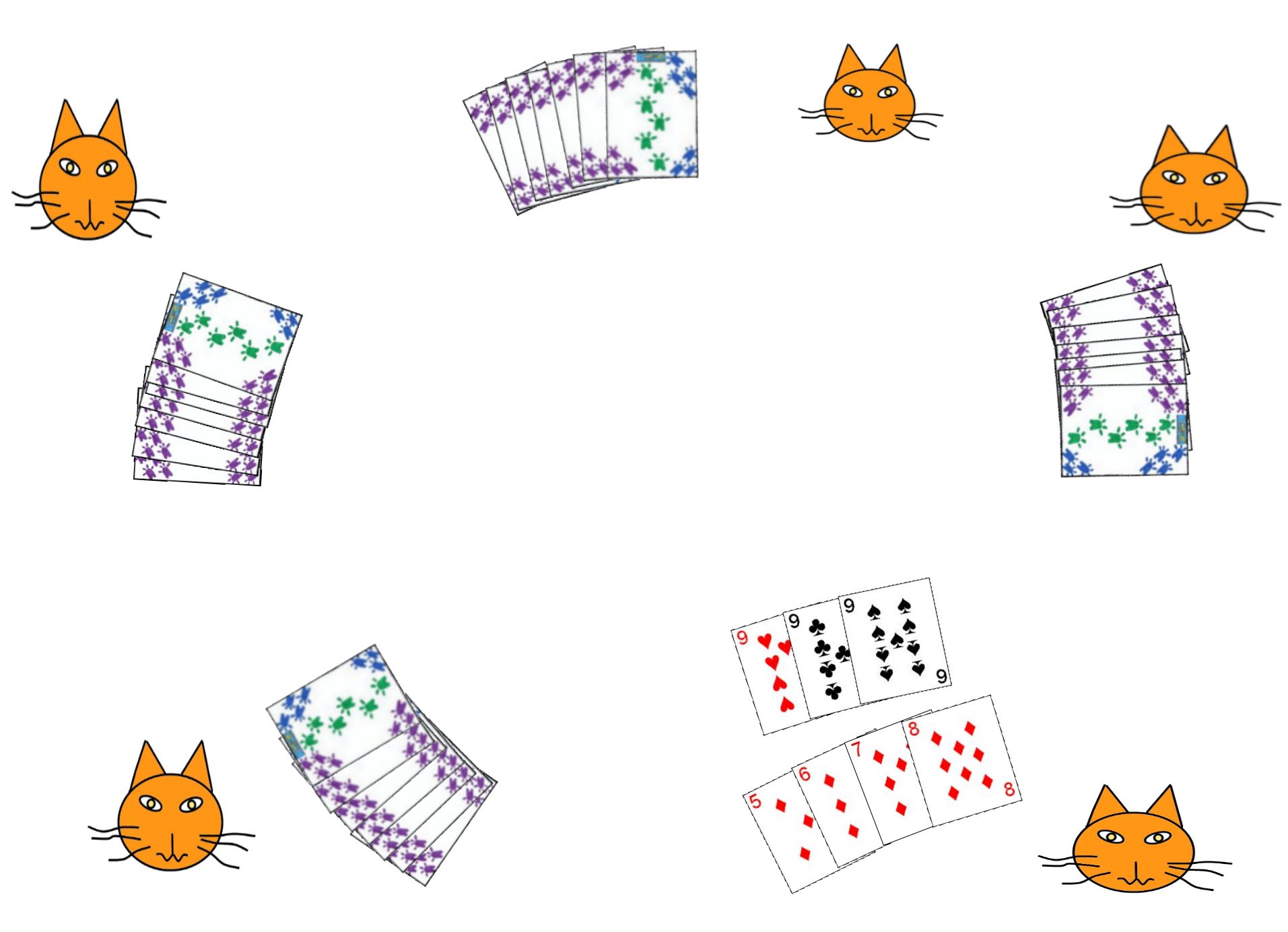 |
Queen City Rum: This version of Rummy designed for 2 to 6 players, is played identically to the standard Rummy rules described above, with a few major exceptions:
In Queen City Rum Each player receives seven cards regardless of the number of players in the game.
No partial melds are allowed. In other words, a player must hold onto his hand until on his turn, he can meld his entire hand at once. The player may meld his entire hand or all but one card which he discards.
In scoring, the player who goes out collects the point value of his own, melded hand, times the number of other players in the game. For example, in the illustration at right, the winning player whose own melds total 53 points would earn 53 multiplied by 4 other players for a grand total of 212 points for the hand.
Phỏm:
Phỏm is a Vietnamese card game of the Rummy family. It is often featured on online card game sites and there are several mobile application implementations of the game. This game is also commonly known as Tá Lả or Vietnamese Rummy. Although played throughout Vietnam, it is particularly popular in the northern areas.
The game uses the standard 52 card deck using the ranking as follows (from High to Low); King, Queen, Jack, 10, 9, 8, 7, 6, 5, 4, 3, 2, Ace.
The game can be played by 2 to 4 players, but is most commonly played by four.
Selection of seating positions and first dealer can be done using any of the standard methods. Once this is determined, the dealer shuffles and distributes 9 face down cards to each player, one by one in a clockwise rotation. The player to the dealers immediate right however, instead receives 10 such cards. The remainder of the deck is set face down in the center of the table to form the stock. The game can be scored using pencil and paper, and another method is to provide each player with an equal number of chips or other tokens. Throughout the course of the game thusly, player will need to transfer chips amongst each other depending on the outcomes of the hands.
After the deal the players then pick up their cards and examine them. The player to the dealer's immediate left begins the hand by discarding a card of his choice to reduce his hand to 9 cards. This starts the discard pile. Play then continues with the next player in turn. Each subsequent player, on his turn, then does several things on his turn.
First, a player either draws the top card from the discard pile or takes the top card of the left-over stock. If a player can use the top card of the discard pile in an existing meld in his hand, he may take this card. If unable or unwilling to take the top card from the discard pile, he must take a card from the stock pile instead (called a Hit). He may never take the next card of the discard pile if unable to use it immediately in a legal meld in his hand. Despite this requirement, the player does not yet show the meld made with this card but retains all melds in his hand. Another important point about taking cards from the discard pile is that no meld may ever contain more than one card actually taken from the discard pile. Thus, each card taken from the top of that pile must be usable in a separate meld. If a player finds that he can meld all cards in his current hand (either with or without a discard on the turn), he goes Rummy (called ù) and immediately wins the hand. The final action a player takes on his turn is to discard a card to the top of the discard pile, ending the turn.
The following are the legal meld types (called Phoms) in this game.
- Three or more cards in sequence of the same suit. As Aces are considered low in this game, an Ace can only appear as the lowest card in a sequence meld.
- Three or four cards of the same denomination.
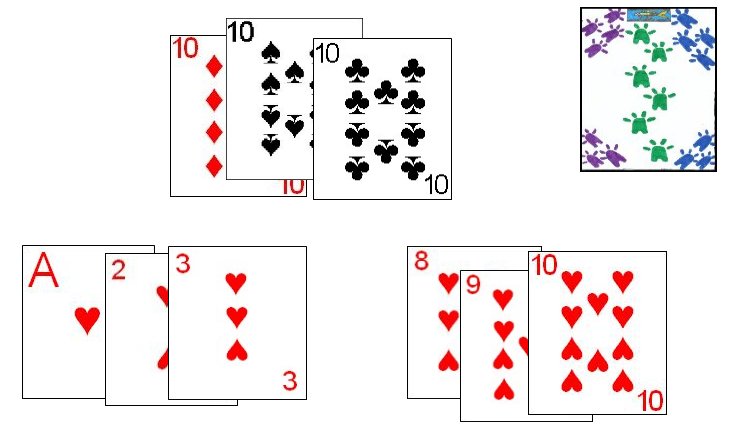
Barring any player going Rummy, the hand continues until each player takes exactly four turns. On his fourth turn, each player must display all legal melds he has on the table before discarding for that turn. Also on his last turn, a player is entitled, if able, to play any non melded cards from their hand onto valid melds that previous players may have already melded to the table on their own last turn. After this occurs, the players then add up the total value of all unmeldable cards (called trash cards) in their hand.
This playing of cards to other players melds is not permissible in the
event another player managed to go Rummy.
Scoring: As mentioned previously, if a player goes Rummy he immediately wins and collects 6 points from each other player if he wins by melding 9 cards. If he can meld all 10 cards (without a discard) this amount is doubled, for a grand total of 12 points per opponent.
If no player was able to go Rummy, each player, on his fourth and last turn will have shown all his valid melds on the table in front of himself. Each player then add the total value of all remaining cards in his hand to determine the point count he is left with. The following chart shows the value for any unmelded cards left in a players hand:
| Card | Unmelded Point Value |
|---|
| Ace | 1 |
| 2 to 10 | Point value marked on card |
| Jack | 11 |
| Queen | 12 |
| King | 13 |
If no player was able to go Rummy, whichever player has the lowest total value in unmelded cards wins the hand. If two players tie for the lowest total, the player who is closest to the dealer in a clockwise rotation is considered the winner. After determining which player has the lowest total, the remaining players then rank themselves in order based on the total point value of unmelded cards in the hand. The player who has the next lowest count after the winner must give that winner 1 point or chip. The player with the next lowest total in unmelded cards is required to give him 2 and the player with the highest count in unmelded cards gives him three. A player, no matter what his score in unmelded cards, who has no legal melds in his hand (called a móm) must give the winner of the hand 4 points or chips.
After a set number of hands, whichever player has the highest grand total is declared the overall game session winner. It is generally advised that each player should have an equal number of turns as the dealer before completing a game session.
In some online versions of the game, players are not able to play cards from their hand to melds made by other participants. In this case, on their last turn when melding to the table, a player may only play his own valid melds to the table and not add to any other players melds.
Another optional rule used in Phỏm, particularly during online games, there are additional penalties applied to players in which the next player is able to take their discard. The following shows the most common such penalties that are sometimes used:
- If the next player in turn takes the last players discard, the player who made that discard must give one chip to the player taking the discard.
- If the next player in turn, allows a player to take three total cards he has discarded and manages to go Rummy, that player must give the chips required not only for himself but all other non-winning players in the round. Those other players then need not give the winner of this hand any chips from their own stock.
German Rummy: German Rummy, also known as Rommé, is the most common variant of Rummy that as played in Germany and Austria. It is played very similar to Standard Rummy save the following differences that distinguish it:
- German Rummy uses two standard 52 card decks shuffled together with the addition of six total Jokers.
- A Joker may be used in a meld to substitute for any card in a meld.
A valid meld may never contain more Jokers than natural cards.
- Melds in German Rummy are traditionally called "figures" and consist of
either Sets (Satzä) or Runs (Sequenzen). A set is 3 or 4 cards all of
the same rank but each of a different suit. A run is 3 or more cards
in direct sequential order, all of the same suit.
- After the deal the remainder of the deck is set face down as a stock pile (called the stoß) and the top card of the stoß is turned face-up and set near the stoß to start a discard pile. On each turn, a player may either draw the top face-up card from the stoß or the top, face-down card of the discard pile.
- An Ace can be considered high (after the King) or low (before two) however an Ace cannot be used between a King and a two.
- If a player has the card in his hand for which a Joker is representing in a meld currently on the table, that player may, on his turn, place his card to replace the Joker. In doing this, however, he must immediately, on that same turn use the Joker in a meld on the table. A player may only do this after he has made his initial meld during that
same hand.
- In the initial deal, each player is dealt a total of 13 cards.
- The first meld a player must make on each hand must total at least 40 points, which must consist of one or more new melds to the table by this player. After a player makes his initial meld to the table he may make any additional melds as able on this or subsequent turns on the same hand
with no point value requirements on those subsequent melds.
- The card point value of each card in the deck is as per the following chart:
| Card | Point Value |
|---|
| Joker | - Used In a meld - point value of card it
replaces
- Remaining in hand at end of game - 30 Points
|
| Jack, Queen, King | 10 Points Each |
| 2, 3, 4, 5, 6, 7, 8, 9, 10 | Value Marked on Card |
| Ace | - Used in a Set - 11 Points Each
- Used in a Run after
a King - 11 Points
- Used in a Run before a two - 1 Point
- Left in Hand - 11 Points
|
These card values are thus considered for purposes of a player's first meld during a hand as well as calculating points at the end of a hand.
- Once one player manages to play his second to last card and discard his last card, that player has won the hand. Each other player adds to his current accumulated score a value equal to the point value of all cards left in his hand.
- After some set number of hands, the player with the lowest total in these penalty points is declared the overall game winner.
In all other aspects this game is played identically to Standard Rummy as described above.
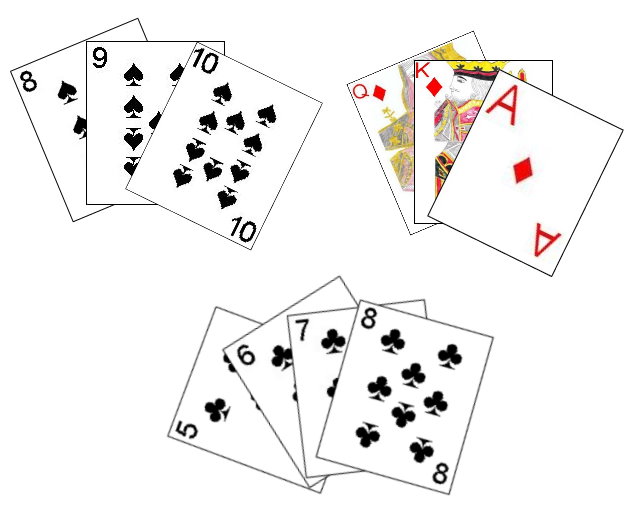 Nowrang:
Nowrang: Nowrang is a two-player Rummy type game which is played in Afghanistan. It uses one standard 52 card deck of cards with no Jokers included. The ranking of the cards are the same as in Standard Rummy, with the Ace considered the highest card, after King.
To begin a hand, the dealer distributes 11 cards to his opponent and 10 cards to himself. He places the remainder of the deck face-down in the center of the table to create a draw pile.
The dealer's opponent then has the first turn of the hand. On this first turn, the dealer's opponent must then simply discard one of his 11 cards to start a draw pile. After this the turn's alternate between the two players.
On each turn a player starts the turn by drawing either the top face-up card of the draw pile or drawing the top face-down card from the stock pile. He then completes his turn by discarding any card from his hand to the discard pile.
The object of the game is to be the first player to form his hand into three sequences of cards (melds of equally ranked cards are not recognized in this game).
These sequences are a series of cards in direct sequential order, all of the same suit. He thus must create one such sequence consisting of four cards (called a garwanj) and two
additional sequences consisting of three cards each. As soon as a player manages to do this during his turn, he indicates this and is declared the winner of the game.
Rami Ta' L-att: Rami Ta' L-att is a variant of Standard Rummy which is played in the Maltese islands. It is commonly played by 2 to
6 players using one standard 52 card deck. The ranking of the cards in the deck
for use in this game is as follows, from highest to lowest; Ace, King, Queen, Jack, 10, 9, 8, 7, 6, 5, 4, 3, 2.
Determination of seating positions and the first dealer can be performed using the same methods as in standard or other forms of Rummy. Once the first dealer has been determined, this player then distributes 10 cards to each player, starting with the player at his immediate left. The remainder of the deck is set face-down in the center of the table as the stock, and the top card of the stock is exposed and set next to the stock to start the discard pile. The player to the immediate left of the dealer has the first turn.
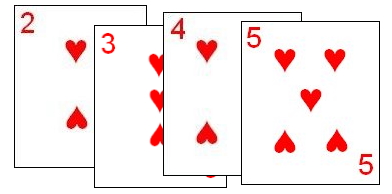
Each turn consists of three actions, a draw, optional melding and then a discard. To start each turn
a player may opt to draw either the top, face-up card from the stock
pile or the top face-down card from the draw pile, adding the drawn card directly into the hand.
After the draw, the player may then, optionally as able and willing,
meld cards to the table. As in standard Rummy, there are two types of
possible melds a player can make, sequence melds (runs) or group melds. A sequence meld is three or more cards, all of the same suit, in direct ascending sequence. A group meld is three or four cards all of the same rank and in different suits.
One special distinction in this game is that a player's first meld must consist of at least one group or sequence consisting of four or more cards. Once a player has made such an initial meld, he may then play any other valid and legal melds and may also lay off cards onto his own melds or those of his opponents.
A player then ends his turn by discarding one card of choice from his hand to the top of the face-up
discard pile.
Once a player manages to go out by either playing his last card to a meld or discarding his last card at the end of a turn, play of that hand immediately ceases. Each player must then add to his ongoing, accumulated score, a total based on the cards found remaining in his hand, as per the following chart:
| Card | Point Value |
|---|
| Ace | 11 Each |
| King, Queen, Jack | 10 Each |
| 2, 3, 4, 5, 6, 7, 8, 9, 10 | Value as Marked on Card |
At the end of a hand, if a player finds his score has reached or exceeded 100 total accumulated points over the course of the game, that player must then drop from the game. The last player remaining after every other player has been forced to drop is declared the game winner.
Copyright © 2015 CatsAtCards.com. All rights reserved.
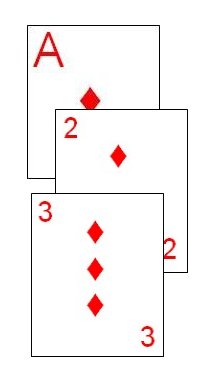 This game is the basis for an entire family of card games which were developed from the basic game Rummy. Described below is the basic game of Rummy (also called Basic Rummy, Straight Rummy, Standard Rummy and sometimes shortened to Rum) as well as a number of variations that are close in rules to the standard game. Specific games such as 500 Rum, Gin Rummy and several others are provided their own separate page as they differ significantly from this basic game.
This game is the basis for an entire family of card games which were developed from the basic game Rummy. Described below is the basic game of Rummy (also called Basic Rummy, Straight Rummy, Standard Rummy and sometimes shortened to Rum) as well as a number of variations that are close in rules to the standard game. Specific games such as 500 Rum, Gin Rummy and several others are provided their own separate page as they differ significantly from this basic game.
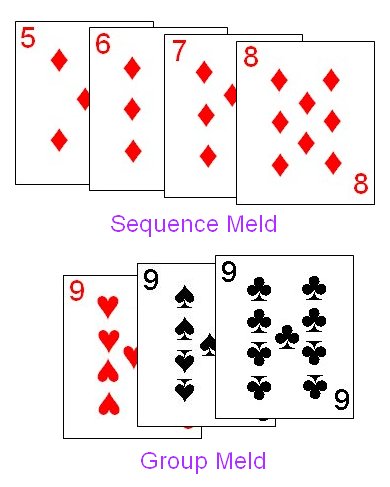 A player begins his turn by first drawing a card. They may either draw the top card from the discard pile or the top card of the stock pile. After drawing, the player may make one or more melds to the table in front of him, if willing and able. After making any melds, a player would then discard one card from his hand face-up to the discard pile ending his turn. The discard should be made in such a manner as only the top card of the
discard pile is visible at any time.
A player begins his turn by first drawing a card. They may either draw the top card from the discard pile or the top card of the stock pile. After drawing, the player may make one or more melds to the table in front of him, if willing and able. After making any melds, a player would then discard one card from his hand face-up to the discard pile ending his turn. The discard should be made in such a manner as only the top card of the
discard pile is visible at any time.
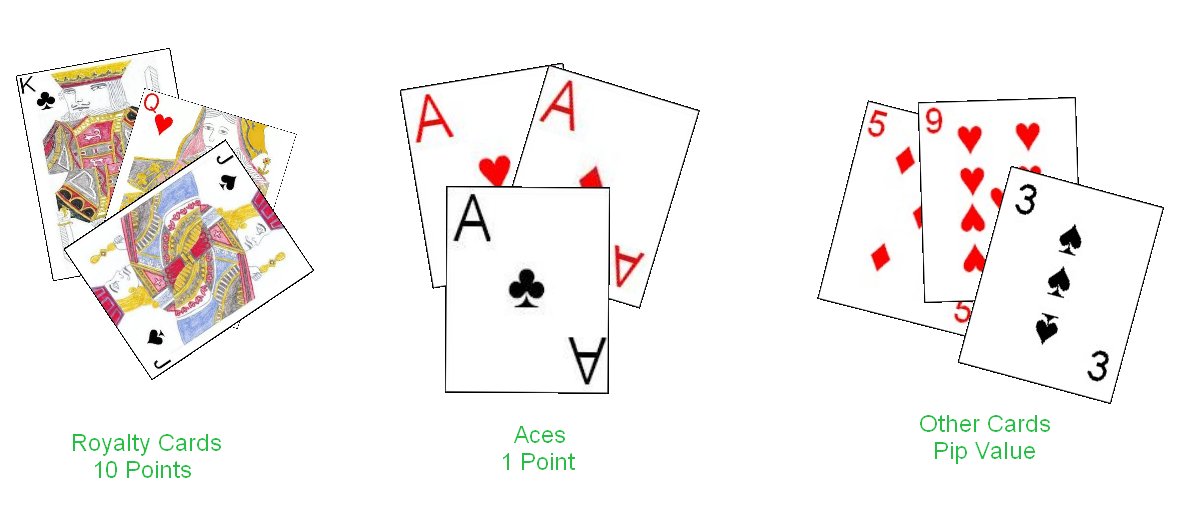


 For sequence melds an Ace is ranked as either high or low. However, Around the corner melds are not allowed. Thus, a player could make melds of (Ace, 2, 3, 4 of Spades) or (Jack, Queen, King, Ace of Diamonds) but a sequence such as (King, Ace, Two) is not allowed. When scoring, the scoring is the same as in the standard game except for Aces which are 15 and Jokers which are 25.
A player's first meld on a hand must total 51 or more points. After making his initial meld in a hand, that player may then make additional melds (or lay off on other melds) to the table without the restriction. Until a player has made his initial meld, he may also not take cards from the discard pile, but only the top card of the stock. However, he may take the top card of the discard pile to use it immediately in his initial meld.
For sequence melds an Ace is ranked as either high or low. However, Around the corner melds are not allowed. Thus, a player could make melds of (Ace, 2, 3, 4 of Spades) or (Jack, Queen, King, Ace of Diamonds) but a sequence such as (King, Ace, Two) is not allowed. When scoring, the scoring is the same as in the standard game except for Aces which are 15 and Jokers which are 25.
A player's first meld on a hand must total 51 or more points. After making his initial meld in a hand, that player may then make additional melds (or lay off on other melds) to the table without the restriction. Until a player has made his initial meld, he may also not take cards from the discard pile, but only the top card of the stock. However, he may take the top card of the discard pile to use it immediately in his initial meld.
 The play of the hand is also the same as in the standard game of Rummy (drawing and discarding), however a player may never make intermediary melds and must meld his entire hand at once when he can. In order to make his meld and win the game, the players melds must fit into one of the following patterns:
The play of the hand is also the same as in the standard game of Rummy (drawing and discarding), however a player may never make intermediary melds and must meld his entire hand at once when he can. In order to make his meld and win the game, the players melds must fit into one of the following patterns:

 Barring any player going Rummy, the hand continues until each player takes exactly four turns. On his fourth turn, each player must display all legal melds he has on the table before discarding for that turn. Also on his last turn, a player is entitled, if able, to play any non melded cards from their hand onto valid melds that previous players may have already melded to the table on their own last turn. After this occurs, the players then add up the total value of all unmeldable cards (called trash cards) in their hand.
This playing of cards to other players melds is not permissible in the
event another player managed to go Rummy.
Barring any player going Rummy, the hand continues until each player takes exactly four turns. On his fourth turn, each player must display all legal melds he has on the table before discarding for that turn. Also on his last turn, a player is entitled, if able, to play any non melded cards from their hand onto valid melds that previous players may have already melded to the table on their own last turn. After this occurs, the players then add up the total value of all unmeldable cards (called trash cards) in their hand.
This playing of cards to other players melds is not permissible in the
event another player managed to go Rummy.
 Each turn consists of three actions, a draw, optional melding and then a discard. To start each turn
a player may opt to draw either the top, face-up card from the stock
pile or the top face-down card from the draw pile, adding the drawn card directly into the hand.
Each turn consists of three actions, a draw, optional melding and then a discard. To start each turn
a player may opt to draw either the top, face-up card from the stock
pile or the top face-down card from the draw pile, adding the drawn card directly into the hand.